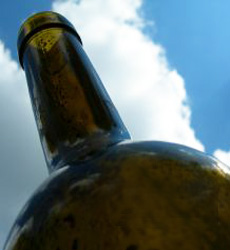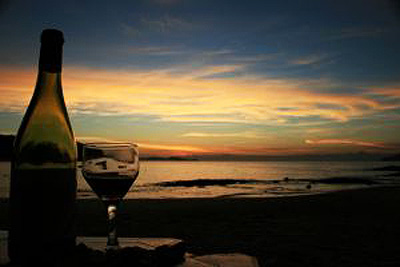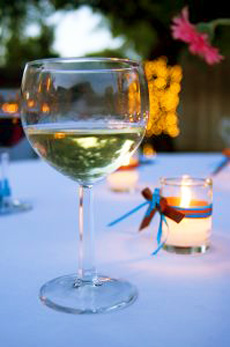

Warm days, blue skies: What wines should you pair with your summer cuisine? Photo by Luk Bog | SXC.
July 2007
|
 |
Product Reviews / Main Nibbles / Wine
The Wines Of Summer
Pairing Wine With Summer Foods
Are there different rules to follow when pairing wines with lighter summer foods? According to Patrick Farrell, one of the country’s 26 Masters of Wine and the creator of the BevWizard Wine Smoother*, you can break the rules to match tastes and textures that complement lighter seasonal summer fare. Here are his recommendations.
*A cap-like device that sits on top of the wine bottle and uses aerating, magnetic technology to soften bitter tannins and astringent flavors as the wine pours into the glass. We haven’t used it yet but plan to try it. Learn more at BevWizard.com.
Reds
- Chilean Reds. Chilean Cabernet, Merlot and Carmenère† are value wines, although they can have some weedy flavors and hard tannins that are more obvious when paired with lighter food. Try them with burgers, hot dogs and ribs.
- Zinfandel and Syrah. These wines can be pretty “big”—big in color, big in alcohol, big in flavor and big in tannins. The “bigness” can easily get in the way of lighter summertime fare, which is why most wine experts advise against them. If you want your Z & S, Farrell suggests serving them at cooler temperatures, which make higher alcohol wines seem lighter.
- Rosé. The quintessential summer wine, Rosé goes well with most summer foods and there are many well-priced bottles. Look for dry Rosé wines from Provence and Languedoc, which pair well with everything from fish to salads to burgers to barbecue.
†One of the six noble grapes of Bordeaux—along with Cabernet Sauvignon, Cabernet Franc, Merlot, Malbec and Petit Verdot, Carmenère was wiped out in Bordeaux after the phylloxera epidemic ravaged French vineyards (and much of the continent) from 1863 to the late 1870s. Viticulturists tried to revive Carmenère by grafting remaining vines onto disease-free rootstock from the U.S. and elsewhere, but the finicky varietal was resistant. Chile has long grown Bordeaux varietals; in the early 1990s, DNA analysis confirmed that much of what Chilean grape-growers thought was Merlot was, in fact, Carmenère, presumably growing there since the 19th century.
| |
 |
| |
While many people think Rosé is the perfect beach wine, die-hard red fans
can tote something heavier—just keep it cool, like the Rosé. Photo by Freddy
Thorvaldsen | SXC. |
Whites
If your preferences are for a white wine, here are two familiar names—one a traditional summer wine, the other less so.
 Sauvignon Blanc. Many wine connoisseurs like to reach for a crisp, cool Sauvignon Blanc on a hot day. While we love Sauvignon Blanc no matter where it’s from, the grassy, citrus flavors of New Zealand SBs pair well with asparagus, goat cheese and seafood. The aggressive, herbaceous flavors of these Sauvignon Blancs are fine for sipping in general. (See some of our particular recommendations of recent bottlings of New Zealand Sauvignon Blanc.) Sauvignon Blanc. Many wine connoisseurs like to reach for a crisp, cool Sauvignon Blanc on a hot day. While we love Sauvignon Blanc no matter where it’s from, the grassy, citrus flavors of New Zealand SBs pair well with asparagus, goat cheese and seafood. The aggressive, herbaceous flavors of these Sauvignon Blancs are fine for sipping in general. (See some of our particular recommendations of recent bottlings of New Zealand Sauvignon Blanc.) - Chardonnay. Surprisingly, these heavier white wines, which most of us enjoy with heartier cool-weather fare, go well with a burger off the grill, or with fish grilled over an oak fire. With oakier Chardonnays, the toasty oak flavors from the grill harmonize with similar flavors in the wine.
Photo by Scott Snyder | SXC.
Let us know about your own favorite summer food and wine pairings.
Lifestyle Direct, Inc. All rights reserved. Images are the copyright of their respective owners.

|






 Sauvignon Blanc. Many wine connoisseurs like to reach for a crisp, cool Sauvignon Blanc on a hot day. While we love Sauvignon Blanc no matter where it’s from, the grassy, citrus flavors of New Zealand SBs pair well with asparagus, goat cheese and seafood. The aggressive, herbaceous flavors of these Sauvignon Blancs are fine for sipping in general. (See some of our particular recommendations of recent bottlings of
Sauvignon Blanc. Many wine connoisseurs like to reach for a crisp, cool Sauvignon Blanc on a hot day. While we love Sauvignon Blanc no matter where it’s from, the grassy, citrus flavors of New Zealand SBs pair well with asparagus, goat cheese and seafood. The aggressive, herbaceous flavors of these Sauvignon Blancs are fine for sipping in general. (See some of our particular recommendations of recent bottlings of